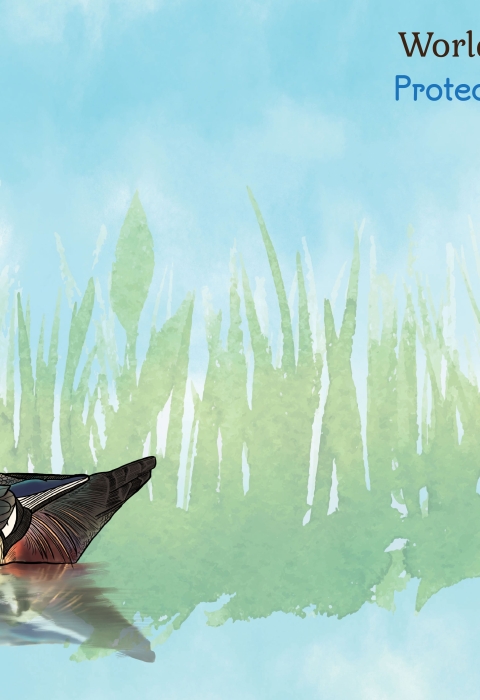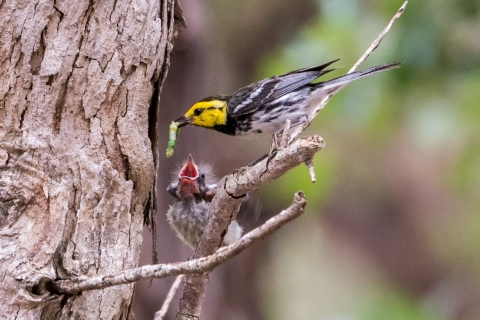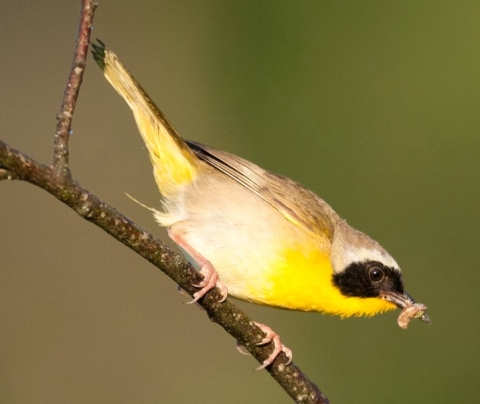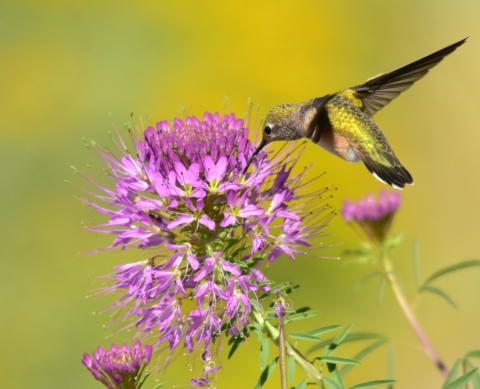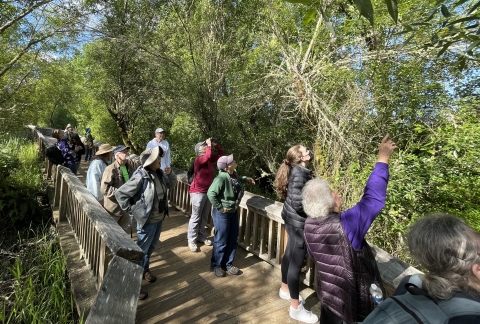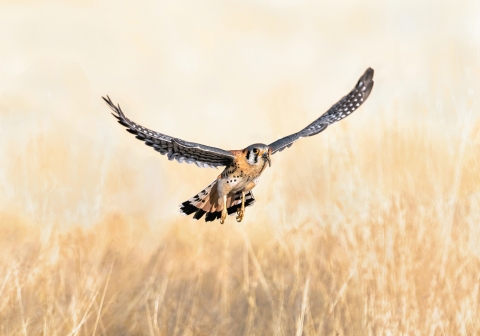World Migratory Bird Day 2024
In 2024, World Migratory Bird Day will be celebrated on May 11 in the spring and October 12 in fall. The conservation theme this year is Protect Insects, Protect Birds, and focuses on the importance of insects as essential food sources for migratory birds.
Insects, the most diverse group of organisms on the planet, are crucial to the food web. They are not only the primary food source for a large majority of bird species around the world, but they also support other species of plants and animals. For birds that depend primarily on insects as their main food source, the ebb and flow of insect populations can greatly affect the timing, duration, and success of their migration. In fact, the timing of migration is highly dependent on when food resources, like insects, will be abundant for birds to replenish their energy reserves at stopover locations in grasslands, forests, and wetlands, along their migratory journeys.
All around the globe, insect populations appear to be declining at unprecedented rates, which can directly threaten birds and their ability to migrate, breed, and produce young. This World Migratory Bird Day, our goal is to increase awareness about the importance of insects as essential energy sources for birds, and support ways to conserve both insects and birds.
Insects & Birds
Each species of bird has evolved over millions of years to eat certain foods. While most migratory songbirds eat seeds, berries, fruits, insects, aquatic invertebrates, grains, larvae, and buds, each individual species has a unique diet. As seasons change, millions of birds migrate to warmer regions where these foods are emerging or still abundant, ensuring they have the energy to meet their needs throughout the year.
For example, the common yellowthroat is an insectivorous migratory bird species, meaning they eat mostly insects, including grasshoppers, dragonflies, beetles, moths, and caterpillars. That means it needs to follow the climate where these insect populations are booming to feed themselves and their young.
Another example is the bobolink, a grassland bird that eats grains and seeds much of the year, but feeds mostly on grasshoppers, beetles, and butterflies during nesting season and to feed their young.
Wood ducks are dabbling ducks that forage in shallow waters. tipping their heads under water (while their bottoms are up!) to eat aquatic plants, algae, small fish, and insects. While the adults eat a mostly herbivorous diet, they rely on insects to feed their young and seek out wetlands with these food resources to successfully raise their young during the summer season before they migrate in the fall.
And while you might know that hummingbirds feed on nectar, they also feed on insects. The broad-tailed hummingbird supplements its diet with insects, and a nesting female can catch up to 2000 insects in a single day!
There are also aerial insectivore birds, like chimney swifts, which eat insects on the wing – meaning they eat insects as they fly around in the air. Chimney swifts dine exclusively on flying insects, eating one-third of their body weight, or about 1000 flying insects, every day!
Aerial insectivores include species of swifts, swallows, martins, nightjars, and flycatchers, and play an important role in ecosystems to help reduce pest insect populations in agricultural and urban areas.
Unfortunately, aerial insectivores have shown the highest percentage of species in population decline than any other bird group, with an estimated 73% of species in decline, representing a loss of 156.8 million birds.
Many of these aerial insectivores are also listed as Birds of Conservation Concern, which are those birds that the Service considers to be of serious conservation risk and require focused conservation attention to prevent their decline to the point of needing consideration for protection under the Endangered Species Act.
In addition to the Birds of Conservation Concern, the 2022 State of the Birds Report listed 70 Tipping Point Species that are on a trajectory to lose another 50% of their remnant populations in the next 50 years if nothing changes.
How You Can Help
Insects live in natural habitats, such as wetlands, streams, meadows, and woodlands, where they fly or waft upward and are eaten by birds and bats. In addition, many insects go through a caterpillar stage when they forage on plant parts such leaves, twigs, buds, or stems.
Insects serve so many important roles: pollinators give us food, beetles keep our soil healthy, praying mantises control pests, and butterflies and moths bring us exceptional beauty as well as being important pollinators.
- Provide or restore bird-friendly habitat by planting or maintaining trees, shrubs, grasses, and flowers that are native to your area. Native plants provide food and other resources for the native wildlife in your area because they evolved together. They benefit more pollinators and other beneficial species than non-native plant species.
- Mow your lawn less in early spring to allow flowers to bloom and help early season pollinators survive. Many insect species overwinter in the stems of plants or on the ground.
- Leave your leaves as pollinators and other beneficial insects rely on the habitat fallen leaves provide, especially over the winter months. Dead leaves also decompose creating compost that can improve soil structure and fertility. Leaving leaf litter and fallen branches on the ground can create natural foraging opportunities and provide cover from predators. This vegetation can provide essential food sources, offer shelter, and nesting sites for a wide variety of species, including pollinators and other beneficial insects' birds eat!
- Discontinue using pesticides and herbicides, which kill or harm insects, birds and the plants that many insects and other wildlife rely on for food.
- Convert your lawn or part of your lawn (which has limited value for insect production) to a native plant garden. Aiming for 70% native plants is a good rule of thumb to benefit pollinators and other beneficial insects. Less lawn means less mowing with both time and money saved. A win-win for you and for wildlife!
- If you own a rural property, encourage fencerows, un-mowed ditches, and natural areas as insect nurseries both at your location and within your community.
- If you live in an apartment, set out a balcony pot of native plants to help feed insects that help feed birds.
- Protect and restore habitats such as woodlands, wetlands, and native meadows where insects live and breed.
- Lights out for birds at night! Keeping artificial lights off between dawn and dusk during fall and spring migration seasons helps birds use the starry night sky to navigate and drastically affects the behavior of insects and pollinators, reducing the ability of plants to produce fruit and reproduce.
- Learn how to make your home safer for birds with our Bird Collision Reduction Toolkits!
- Spread the word and help educate others!
Join the Global Effort!
Find out what events are happening in your area !
U.S. Fish and Wildlife Service events:
- May 10 - Horicon National Wildlife Refuge (Wisconsin) Horicon Marsh Bird Festival Hosted by Horicon Marsh Bird Club, and Wisconsin Department of Natural Resources.
- May 11 - National Conservation Training Center (NCTC) Open House (West Virginia)
- May 11 - Canaan Valley National Wildlife Refuge (West Virginia) guided bird walk. All ages and birders of any level welcome. Program includes activities for the whole family to enjoy, including children's activities like story-time and crafts!
- May 11 - Muscatatuck National Wildlife Refuge (Indiana) "Wings Over Muscatatuck Bird Festival" featuring refuge tours and guided bird walks, children's activities, native plant sale, and lots of other exhibits and activities for all ages.
- May 11 - Trempealeau National Wildlife Refuge (Wisconsin) Annual Birding Festival! There will be early bird hikes, presentations, and live raptors for the entire family to enjoy.
- May 11 - DeSoto and Boyer Chute National Wildlife Refuges along the Missouri River (Iowa & Nebraska) spring bird count led by refuge volunteers and local birders. Birders of all levels and ages welcome!
- May 18 - Sherburne National Wildlife Refuge (Minnesota) free annual Spring Celebration event. All ages welcome! Come learn more about birds, pollinators and native plants. This event will be mostly outdoors and will feature a presentation on insects, live bee display, several interpretive booths, nature crafts, a story walk, the Friends of Sherburne silent auction, the Eagle's Nest Nature Store and a local food truck.
NEW! Bureau of Land Management (BLM) released a new Junior Ranger Mission called ‘Celebrate Migratory Birds.’ Junior Ranger Missions are virtual games featuring BLM science and heritage information that can be played on digital devices for free by anyone, anytime. They encourage children to move, play, and explore their public lands by completing virtual “Adventures” and tackling educational challenges through observation and exploration.
To play the game, download the Agents of Discovery app from your preferred app store, search for “Celebrate Migratory Birds (Virtual, Play Anywhere!),” and enjoy helping Agent Kestrel protect migratory birds on public lands near you! Make sure to select the “Virtual, Play Anywhere!” version, as the other versions are geolocated to particular BLM field sites. Find more information on the webpage here.
